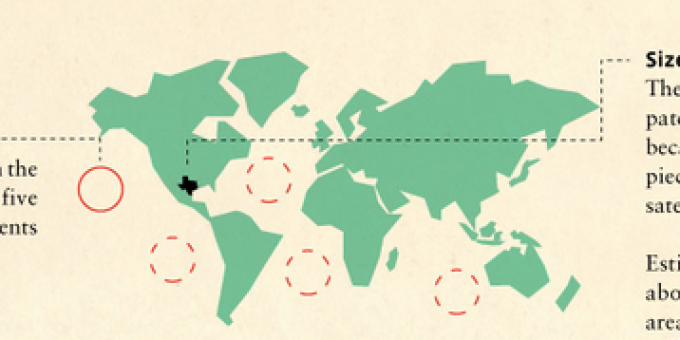
Think back to the movie Erin Brockovich. The basic plot, based on a true story, goes like this: A woman with no legal training learns that many residents in a small town have gotten cancer due to exposure to contaminated groundwater. After investigating a large factory believed to be responsible for the contamination, Brockovich proceeds to kick ass. She files a lawsuit against the company, bringing justice to the sick families.
It’s the perfect drama-filled Hollywood plot. Yet what is even more dramatic is that the basic story of communities living in contamination isn’t rare at all. In many places around the world and in the U.S., people share their neighborhoods with hazardous waste, toxic incinerators, and health-threatening chemical contamination. Moreover, some people are much more likely to be affected by these environmental hazards than others—namely, people of color, working class people, immigrants, and indigenous communities.
This uneven exposure to environmental risks and hazards, often coupled with the systematic exclusion of people from environmental decision-making processes, is called environmental racism or environmental inequality. But, don’t be fooled by the terms—the causes of environmental inequality are social and political. In other words, environmental inequality is not, at its core, an environmental issue. Rather, it is rooted in our discourses, structures, and political and economic institutions, and it is intertwined with the other inequalities that permeate our daily lives.
The Emergence of Environmental (In)Justice
Although Erin Brockovich hit the theaters in 2000, environmental inequalities are far from new and far from over. Native Americans, African Americans, Latinos, and European immigrants in the Unites States have long been disproportionately exposed to the harmful effects of living near city dumps, working in coal mines and on farms picking pesticide-drenched produce, and bearing the brunt of undemocratic and destructive land use decisions. But it wasn’t until researchers, activists, and government officials began documenting patterns of social inequality and environmental harm in the 1970s and early 1980s that the concept of environmental inequality emerged.
For example, the U.S. General Accounting Office conducted one of the earliest studies of environmental inequality in 1983. The study examined the racial composition of communities near four major hazardous waste landfills in the South. In three of the four cases, the communities around the landfills were predominantly African American (in the fourth, the community was disproportionately African American). Several other groundbreaking studies in the 1980s and 1990s confirmed these patterns at the local, regional, national, and even international scales.
In response, scholars and activists began calling for environmental justice. According to sociologist Robert Bullard, environmental justice is the notion that all people and communities are entitled to equal protection by environmental health laws and regulations. Many researchers and advocates have rallied around this concept, which has influenced a body of scholarship on environmental inequalities as well as an ever-growing social movement to combat them.Initial Documentation and Response to Environmental Inequalities
Scholars and movement activists began to address environmental inequalities by first documenting their existence. Since the 1980s, there have literally been thousands of studies that have provided strong evidence of racial inequalities in exposure to environmental hazards. Many other scholars have argued that environmental inequalities do not just disproportionately affect racial minorities. Other social categories, like gender, age, class, immigration status/citizenship, and indigeneity, are also associated with disproportionate exposure to hazards. Taken together, these effects overlap and are difficult to disentangle. Here, we focus on race and class, as these are the most prominent in existing studies.
Rather than reviewing these studies (which could fill books), we turn to two examples in the city of Chicago. The Southeast portion of Chicago is known locally as “the Toxic Doughnut” because it is surrounded on all sides by hundreds of polluting industrial facilities, including paint manufacturers, landfills, a sewage treatment plant, a steel manufacturing company, incinerators, and several dumps. Each year, these local industries emit hundreds of thousands of pounds of chemicals into the air. Local residents, who are predominantly African Americans living in public housing, report high incidences of asthma, chronic obstructive pulmonary disease, skin rashes, and cancer.
Scholars like Bullard, Beverly Wright, Bunyan Bryant, and Dorceta Taylor (among others) founded the field of environmental justice studies in order to document inequalities like these. Yet, unlike the Hollywood portrayal, it is actually very difficult to link health problems to specific chemical or industrial sites, especially when several exist in the same area. While this means the resolution depicted in Erin Brokovich is not representative, it also means that there are many other responses to environmental inequalities.
In the mid-1980s in the Toxic Doughnut, for example, several activists engaged in an act of civil disobedience against a chemical waste incinerator operator. They coordinated a “lock down” and chained themselves to vehicles placed in the path of trucks transporting hazardous materials for incineration. By the end of the day, the coalition had turned away no less than 57 waste trucks.
Such acts of civil disobedience have been common responses to perceived environmental injustices, though this particular story doesn’t end at the incinerator gates. The activists involved in the lock down joined a broader network of organizations that comprise the environmental justice movement, and they collectively pushed then-president Bill Clinton to sign an Executive Order (12898), directing federal agencies to develop and implement plans to guard against the production of environmental inequalities. It was an historic accomplishment for the environmental justice movement, though the fight for environmental justice was (and is) far from over.
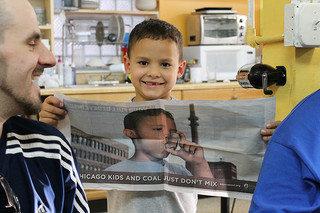
In fact, 20 years later in the same city, things hadn’t changed much. Many of Chicago’s Latino communities are concentrated in the neighborhoods of Pilsen and Little Village on the city’s West Side. In the early 2000s, activists in these communities began a campaign to shut down two coal-fired power plants. Pollution from the Fisk (in Pilsen) and Crawford (in Little Village) plants are, according to researchers from Chicago’s Clean Air Task Force, largely responsible for 42 premature deaths, 66 heart attacks, and 720 asthma attacks each year. Community organizations from environmental, faith, health, and labor movements across the city came together to form the Clean Power Coalition (CPC) not only to phase out the power plants, but also to make Chicago a coal-free city. The CPC eventually received support from 35 aldermen and the Mayor. In 2012, the organization achieved its goal. An agreement was signed to close the Fisk plant within the year and the Crawford plant in 2014. It was a major victory for the environmental justice movement and for one of the lead organizations in the CPC, the Little Village Environmental Justice Organization.
Causes of Environmental Inequalities
As the fight for environmental justice wages on, scholars have turned their attention to better understanding why environmental inequalities exist. Various explanations have been proposed, and here we focus on two—economic and discrimination-based explanations. Socio-political explanations are also at play, but since power and politics are everywhere, we integrate them into the first two. As noted above, none of these are fundamentally environmental causes—they are rooted in society.
Economic Explanations
A common explanation for environmental inequality is that polluting corporations do not intentionally discriminate. Instead, they place facilities where land is cheap and where labor pools are available. Both help companies in their quest to maximize profits. Often, marginalized communities already live in such areas, and once a hazardous facility is present, they likely lack the resources to move.Focusing on the broader social system, sociologists Allan Schnaiberg and Kenneth Gould developed a related economic-based explanation called the treadmill of production thesis. Under this model, there is an ever-growing need for capital investment to generate goods for sale in the marketplace, and that requires continuous inputs of energy and expansion. This expansion of the economy drives two fundamental dynamics: the creation of economic wealth and the creation of the negative byproducts of the production process. The social and economic benefits are unevenly distributed in favor of businesses and affluent communities, while the environmental risks and other negative byproducts are disproportionately concentrated among the groups of people with the least ability to resist the location of polluting facilities in their community. Thus, polluting facilities are sited among the most vulnerable groups: the poor, unskilled laborers, and skilled bluecollar residents.
Scholar and theorist Ulrich Beck further expands this idea with a model of the interactions among technology, social dynamics, and ecological degradation. For Beck, a key aspect of the process of modernization is the application of scientific research and knowledge to expand economic growth. Driven by the need to maximize profits, corporations continually develop new technologies that produce unforeseen risks for the entire society. This breaks down society’s ability to ensure the safety of its citizens from the production of industrial hazards and creates a “risk society” in which the uneven distribution of benefits associated with economic production is compounded by the uneven distribution of environmental pollution. Thus, environmental injustice.
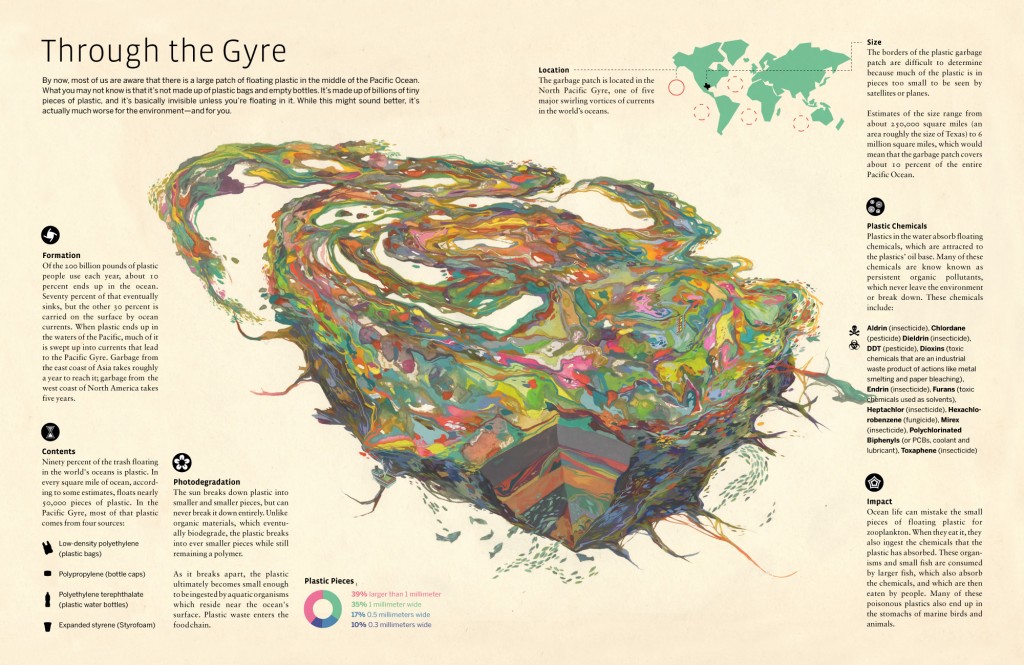
Discrimination-based Explanations
Other researchers focus more directly on racism and institutional discrimination as drivers of environmental inequality. As evidence, they point to the persistent and stark racial divides in environmental policy making. For example, scholars like Charles Mills and Robert Higgins point to the ways that racism informs environmental decision making on a deeper cultural register. Mills draws on philosophy and historical texts to connect racism to a psychological, cultural, and legal framework linking images of people of color (specifically people of African descent) with barbarism, filth, dirt, and pollution. According to Mills, many white people view African peoples as a form of pollution, making it morally easier to contain industrial waste and factory pollution in their segregated, already-“polluted” neighborhoods. This link between non-European peoples and symbols associated with nature, such as danger, disease, and the primitive savage, is common throughout European history and literature, as well as within contemporary politics in the global North, whether one is speaking of Africans, African Americans, Indigenous peoples, Asians, Latin Americans, or the Roma of Europe.
Like Mills, environmental philosopher Robert Higgins argues that “minority” environments are seen as “appropriately polluted” spaces. Immigrants, indigenous populations, and people of color are viewed by many policymakers, politicians, and ecologists as a source of environmental contamination. That view influences and supports decisions to place noxious facilities and toxic waste in the spaces these populations occupy or relegate these groups to spaces where environmental quality is low and undesirable.
Racial disparities are also mirrored in myriad other aspects of environmental justice-relevant U.S. institutions, including education, health care, and criminal justice, revealing how environmental inequality’s impacts can multiply and ripple across the social terrain far beyond those spaces traditionally associated with “environmental” issues. Often, however, particular acts of racism and discrimination cannot easily be located and measured, as racism is not a specific thing and its effects cannot be neatly isolated or extracted from social life, so scholars must continue to explore creative approaches to study this problem.As we consider economic- and discrimination-based explanations for environmental injustice, politics are clearly at play in both. The political power of communities, states, and industries is inseparable from racial and economic forces driving environmental inequalities. For one, industries and corporations might purposefully seek the path of least resistance. As affluent, and often white, communities have the resources and social capital to oppose the placement of hazardous facilities in or near their neighborhoods, companies place hazards in locations where they believe they will meet little or no local political resistance. Communities that are already socially marginalized are often excluded from participation in policymaking, zoning, and urban planning, while industries, corporations, and similar entities are highly involved in these processes. It’s just easier to site industrial operations in neighborhoods where the residents have long held little political clout. In addition, working class communities and communities of color are relatively invisible in mainstream environmental movements. If the voices of disadvantaged communities are not heard or respected in political or protest circles, they can be overlooked. Multiple forms of hierarchy and politics drive environmental inequalities.
Expanding Environmental Justice
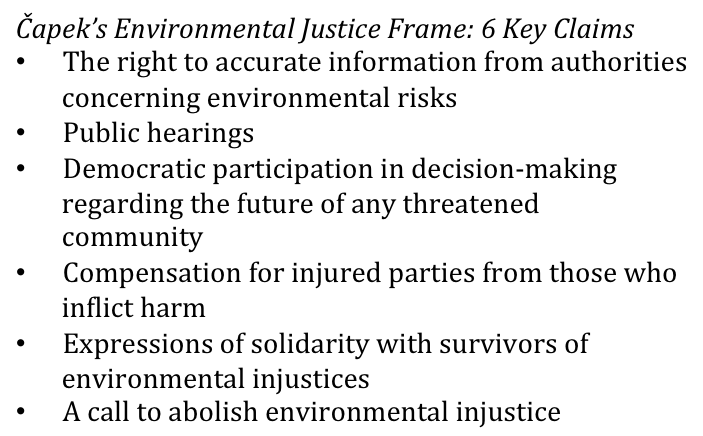
Though the scholarly field (and related social movements) of environmental justice studies began by focusing on unequal exposure to environmental hazards, some scholars and activists have expanded its boundaries. In 1993, sociologist Stella Čapek introduced the environmental justice frame, which she saw as a lens through which activists and scholars constructed meaning about environmental justice. According to Čapek, the environmental justice frame consists of six key claims (see right).
Čapek’s model highlights something that we have hinted at—environmental injustice is not just about disproportionate hazards; it is also about access to decision-making capabilities, democratic process, and power.
More recently, scholars have analyzed how other aspects of social life (beyond race and class) influence environmental inequalities. For example, environmental hazards can affect women differently than men. In places like Silicon Valley, where the electronics industry boom began decades ago, the majority of workers in the most chemically intensive jobs were immigrant women (some were exposed to upwards of 700-1,000 different chemicals in a single workstation). Gender also plays a strong role in how people confront environmental hazards. As research by Phil Brown and Faith Ferguson and Celene Krauss demonstrates, women have been the most visible and vocal advocates for the environmental justice movement. This is largely because of their social structural position as likely caretakers of children and the elderly (often the first members of families and communities to show signs of environmental illness) and the most likely to have strong connections to community-based institutions like schools, churches, health clinics, and salons—sites where information and concerns about environmental threats are shared and where people are often mobilized.
Environmental justice scholars are working to expand the concept in other ways as well. Notably, while we have focused on the United States in this piece, scholars are increasingly seeing environmental inequalities as global issues. For example, the practice of hazardous waste dumping across national borders is a form of transnational environmental inequality. Every year, wealthy nations and corporations produce millions of tons of toxic waste from industry, consumers, municipalities, state institutions, computers and electronics products, and agricultural practices. These hazards directly and indirectly contribute to high rates of human and non-human morbidity and mortality and to ecosystem damage on every continent and in every ocean system. Dumping waste in other people’s “backyards” is reflective of economically, racially, and politically unequal relations between and within global North and South communities.
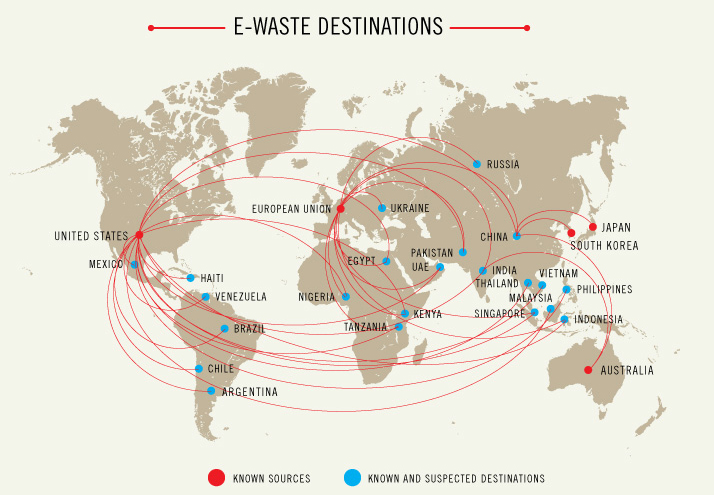
Climate change is another example of global environmental inequality. While contributing the least to the causes of climate disruption, people of color, women, indigenous communities, and global South nations often feel the brunt of climate disruption. They bear the burdens of ecological, economic, and health effects, thereby giving rise to the concept of climate injustice. These communities are among the first to experience the effects of climate disruption, which can include “natural” disasters, rising levels of respiratory illness and infectious disease, heat-related morbidity and mortality, and large increases in energy costs. Flooding from severe storms, rising sea levels, and melting glaciers affect millions in Asia and Latin America, while sub-Saharan Africa is experiencing sustained droughts. Yet, nearly 75% the world’s annual CO2 emissions come from the global North, where only 15% of the earth’s population resides.
The ability to adapt to climate change is also highly uneven across social groups within countries. For example, African Americans have fewer resources to cope with or recover from a host of negative health impacts that might result from climate change. For example, they are 50% more likely than non-African Americans to lack health insurance. The delivery of disaster relief is less available to African Americans, too. This was made evident in the aftermath of Hurricane Katrina, when the Federal Emergency Management Agency failed to provide services to thousands of African Americans in the Gulf region who were without shelter, food, or drinkable water for days. Research demonstrates that racial stereotypes continue to contribute to reduced disaster relief aid for African Americans in the wake of all manner of climate-related emergencies.Gender inequalities impact the ability to adapt to climate change as well. In Bangladesh, for instance, women’s domestic duties have historically made them especially vulnerable to extreme weather events like storms and floods. Responsibilities as the primary child care givers, primary gatherers of food, fuel, water, and the primary cooks and tenders of livestock have typically tied women to low-lying residences, which are more vulnerable to the rising waters associated with extreme weather events. The relative poverty of women in Bangladesh also makes them less resilient in the face of climate change, since they have poorer nutrition, limited health care, and, in the case of divorced and widowed women, fewer sources of social support.
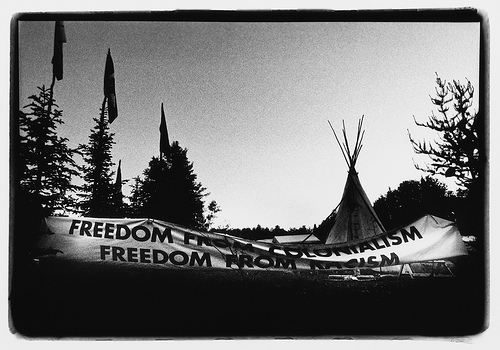
A Global Response
Today, the real Erin Brockovich continues to participate in other environmental justice lawsuits, and activists living in The Toxic Doughnut and on Chicago’s West Side are still orchestrating grassroots campaigns for environmental justice, including a push to improve the city’s public transit system and promote sustainable energy production. The movement is much broader, with grassroots activists, scholars, governmental, and even corporate actors converging around these pressing issues. At the global level, too, international treaties have come to recognize global environmental injustices tied to climate change and the transfer of hazardous waste to the global South. Yet, despite some of the successes of these transnational advocacy movements, environmental inequalities persist.
Multiple solutions at all levels are needed to comprise a global response to environmental inequality. The United States can and should do its part. While new laws may be needed over time, right now we believe we must start with the enforcement of existing laws that are relevant to environmental justice. The Executive Order referenced earlier was intended to ensure that federal agencies function in a way that protects communities against environmental inequalities. Unfortunately, as the U.S. government’s own Inspector General has concluded, federal agencies are doing a poor job of implementing Order 12898, and there have been varying and uneven levels of commitment from the White House, Congress, and the U.S. Environmental Protection Agency since it was signed in 1994.Many other solutions—far more than we can review here—are needed, but enforcing the laws already on the books is a good start.The first of many needed responses to environmental injustice, then, is for the federal government to enforce a host of existing laws intended to protect the environment, human health, and vulnerable communities. Laws like the National Environmental Policy Act, the Clean Air Act, and the Fair Housing Act have been under attack by industry and special interest groups since their passage, and each has been weakened over the years. As a result, it has become more difficult—not less—for working class people and people of color to find jobs, homes, and recreational spaces that are free from toxic hazards. Many other solutions—far more than we can review here—are needed, but enforcing the laws already on the books is a good start.
Recommended Readings
Phil Brown and Faith I.T. Ferguson. 1995. “‘Making a Big Stink’: Women’s Work, Women’s Relationships, and Toxic Waste Activism.” Gender & Society 9:145-72. An excellent analysis of the many ways that gender shapes the way we define and respond to environmental hazards.
Robert D. Bullard and Beverly Wright. 2012. The Wrong Complexion for Protection: How the Government Response to Disaster Endangers African American Communities. New York: New York University Press. A pioneering study of the history of institutional racism in disaster readiness, response, and recovery and its effects on African Americans.
Stella Čapek. 1993. “The ‘Environmental Justice’ Frame: A Conceptual Discussion and an Application.” Social Problems 40(1):5-24. A theoretically rich and grounded study that captures a core of the environmental justice movement’s interpretation of harm and its vision of what justice might look like.
Paul Mohai and Robin Saha. 2007. “Racial Inequality in the Distribution of Hazardous Waste: A National-Level Reassessment.” Social Problems 54(3):343–70. A methodologically innovative study that applies new techniques for measuring community proximity to hazardous waste sites and finds that racial disparities (i.e., environmental racism) for these land uses are much worse than previously thought.
David N. Pellow 2007. Resisting Global Toxics: Transnational Movements for Environmental Justice. Cambridge, MA: The MIT Press. A detailed analysis that traces transnational waste dumping and the global environmental justice movements that have emerged in response.
J. Timmons Roberts and Bradley Parks. 2007. A Climate of Injustice: Global Inequality, North-South Politics, and Climate Policy. Cambridge, MA: The MIT Press. A groundbreaking analysis of the intersections between climate change and social inequality and how this directly affects the process of climate negotiations.

Comments 5
Letta Page — September 20, 2013
For a teaching resource to help bring this article into the classroom as an exercise not on environment but on how environment ties into "life chances" ("the odds that an individual will obtain the resources and opportunities necessary for a long and successful life") see Teaching TSP: http://thesocietypages.org/teaching/2013/09/19/environmental-inequality-class-and-life-chances/
Serge de Gheldere — September 29, 2013
Hello,
This is interesting. This thought, extended to global warming related damage, is behind the book "Revolution Justified", by Roger Cox.
The huge delay between the cause and the damage in the examples you mention is similar between the emissions of greenhouse gases, and the global warming related damage incurred decades later. For example, we are now only fully feeling the effects of greenhouse gas emissions accumulated up until the 1980's. With 30 to 50 years delay.
What is very different, though, is that driving your fossil-fuel-powered car or buying your electricity from a coal-fired power-plant, not only results in damage many decades later, but may very well hit people in Bangladesh or in Sudan.
And yet, this is no reason for inaction, as the supreme court in the US judged when ruling that CO2 is an air-pollutant.
Yesterday, on the basis of this book, the citation for a lawsuit against the Dutch state was put online at:
http://www.wijwillenactie.nl/wp-content/uploads/2013/09/Dagvaarding-concept-26-9-2013-v7-Final-T.pdf
only in Dutch, for the moment.
We are going to file a similar claim in Belgium, and groups in the UK and in Spain are organizing themselves as well.
Interesting times.
Serge dG
Friday Roundup: Sept. 20, 2013 » The Editors' Desk — April 1, 2014
[…] “Environmental Inequalities,” by Hollie Nyseth Brehm and David Pellow. We think of environmental damage as infesting specific sites (Erin Brokovich, anyone?) or being a fully global problem (ozone layer: we need one). Brehm and Pellow urge us to consider the ways in which environmental hazards work to more directly impact the most vulnerable global citizens. […]
Environmental Justice | Pearls of Green Wisdom — February 13, 2016
[…] injustice and pollution, no one cares. If you want to read a specific example from Chicago, check this out. Also, here is an example about Cancer Alley in Louisiana which is home to primarily […]
An economic explanation for economic and environmental inequality in the United States | Integrated Ecological Solutions Website — August 6, 2016
[…] following text was copied from a White Paper by Hollie Nyseth Brehm and David Pellow titled Environmental Inequalities that was published on The Society Pages. The complete URL is: […]